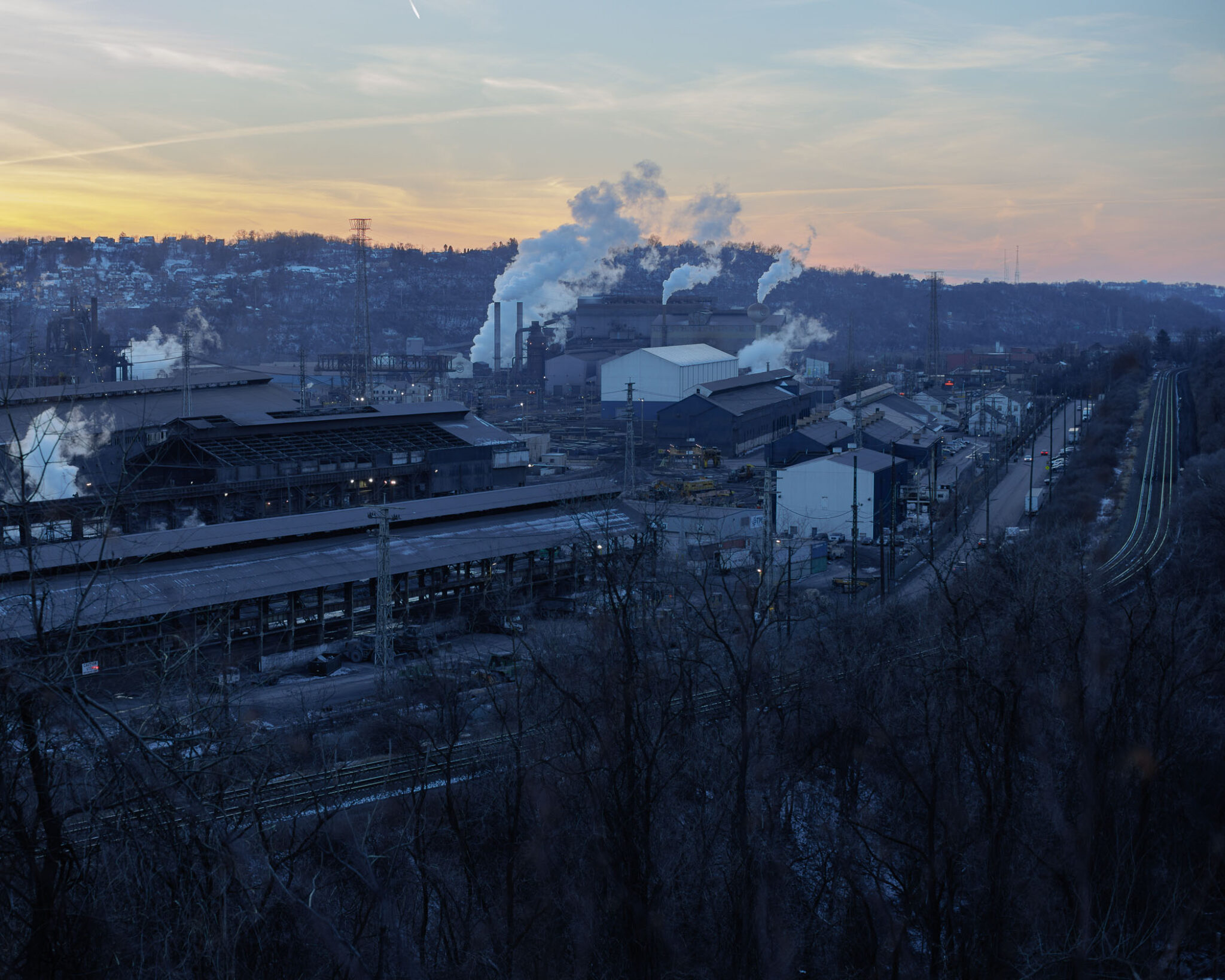 Along the Monongahela River, Braddock Avenue runs between train tracks and U.S. Steel’s Edgar Thomson Works, which occupies parts of Braddock, North Braddock, East Pittsburgh and North Versailles. Credit: Quinn Glabicki/PublicSource
Along the Monongahela River, Braddock Avenue runs between train tracks and U.S. Steel’s Edgar Thomson Works, which occupies parts of Braddock, North Braddock, East Pittsburgh and North Versailles. Credit: Quinn Glabicki/PublicSourceThis article was originally published by PublicSource, a nonprofit newsroom serving the Pittsburgh region. Sign up for its free weekly newsletters here.
“My name is Edith Abeyta.”
The word ‘question’ was tattooed across the backs of her fingers, which shook slightly as she spoke.
“I live in North Braddock. I live in a sacrifice zone. I live in a dystopia.”
A collection of engineers, scientists and officials from the U.S. Department of Energy [DOE] peered back at her, seated in a conference room at an agency-sponsored carbon capture workshop at Hazelwood Green in December.
“You may ask: How did I get here? Why is it that I am standing here talking to you today?”
Edith, a professional artist and self-described “activist for imagination,” has led grassroots advocacy in her community since 2014. She successfully organized to stop bids to frack at U.S. Steel’s Edgar Thomson Works and at the Grand View Golf Club in North Braddock, Pennsylvania.
For months, she and a handful of locals representing North Braddock Residents for Our Future had been speaking with department officials.
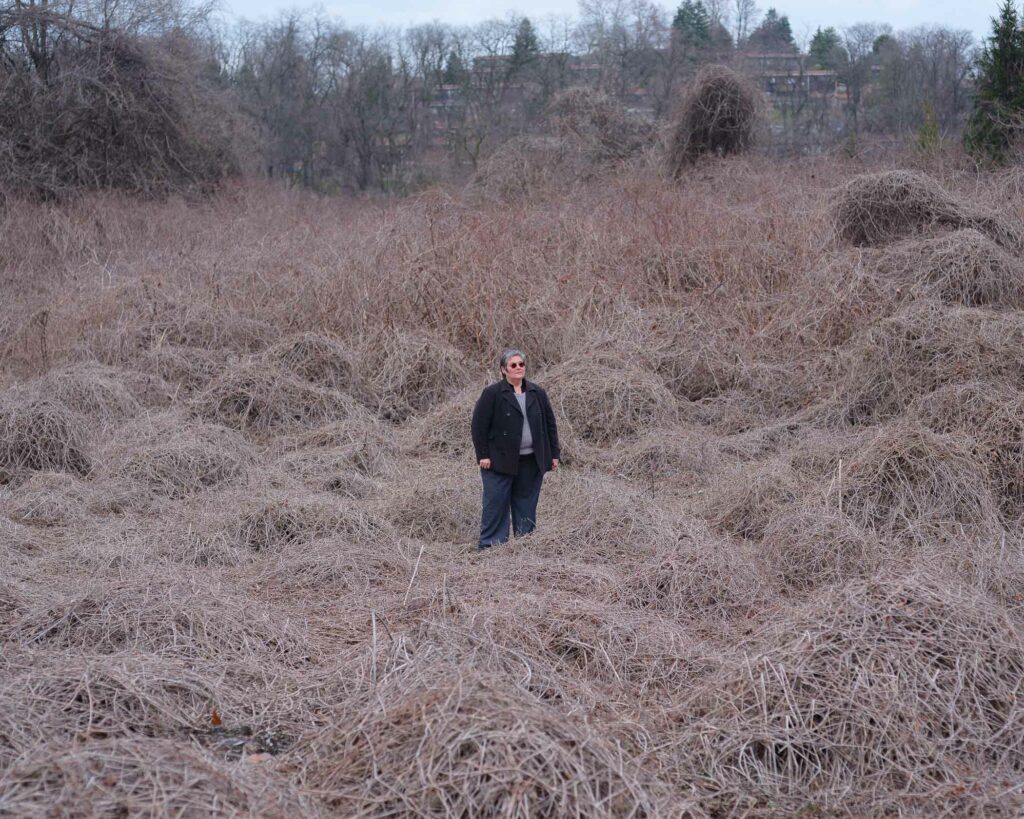
Edith Abeyta stands in a patch of invasive vine overgrowth in North Braddock. “The scale and finances of these projects must include everyone. They must lift up all the people who live next to it and in the region,” said Edith at a workshop with U.S. Department of Energy officials. “What good is a carbon capture and storage facility in a community without a school or a grocery store, even if we are to believe the impacts are minimal, not disruptive, and we are safe?” Credit: Quinn Glabicki/PublicSource
“My name is Edith Abeyta.”
The word ‘question’ was tattooed across the backs of her fingers, which shook slightly as she spoke.
“I live in North Braddock. I live in a sacrifice zone. I live in a dystopia.”
A collection of engineers, scientists and officials from the U.S. Department of Energy [DOE] peered back at her, seated in a conference room at an agency-sponsored carbon capture workshop at Hazelwood Green in December.
“You may ask: How did I get here? Why is it that I am standing here talking to you today?”
Edith, a professional artist and self-described “activist for imagination,” has led grassroots advocacy in her community since 2014. She successfully organized to stop bids to frack at U.S. Steel’s Edgar Thomson Works and at the Grand View Golf Club in North Braddock, Pennsylvania.
For months, she and a handful of locals representing North Braddock Residents for Our Future had been speaking with department officials.
The DOE’s newly formed Office of Clean Energy Demonstrations [OCED] last year announced a funding process for a national buildout of four regional hydrogen [H2] hubs, in an attempt to decarbonize heavy industries like steelmaking. A hub in this region would more than likely make “blue” hydrogen using fracked natural gas. Local leaders and industrial titans like U.S. Steel, Shell and Norway-based gas giant Equinor have pledged to collectively advance the project.
North Braddock Residents for Our Future responded with concern.
“Already, we see that regional elected officials and business elites are launching vigorous campaigns to ‘win’ H2Hub development awards,” they wrote to the agency last March. “Yet our region also has a long and ongoing history of energy extraction, and an accumulated legacy of past and recent industrial development.”
The group viewed the hydrogen hub initiative “with deep concern, and even some degree of cynicism, born from that experience.”
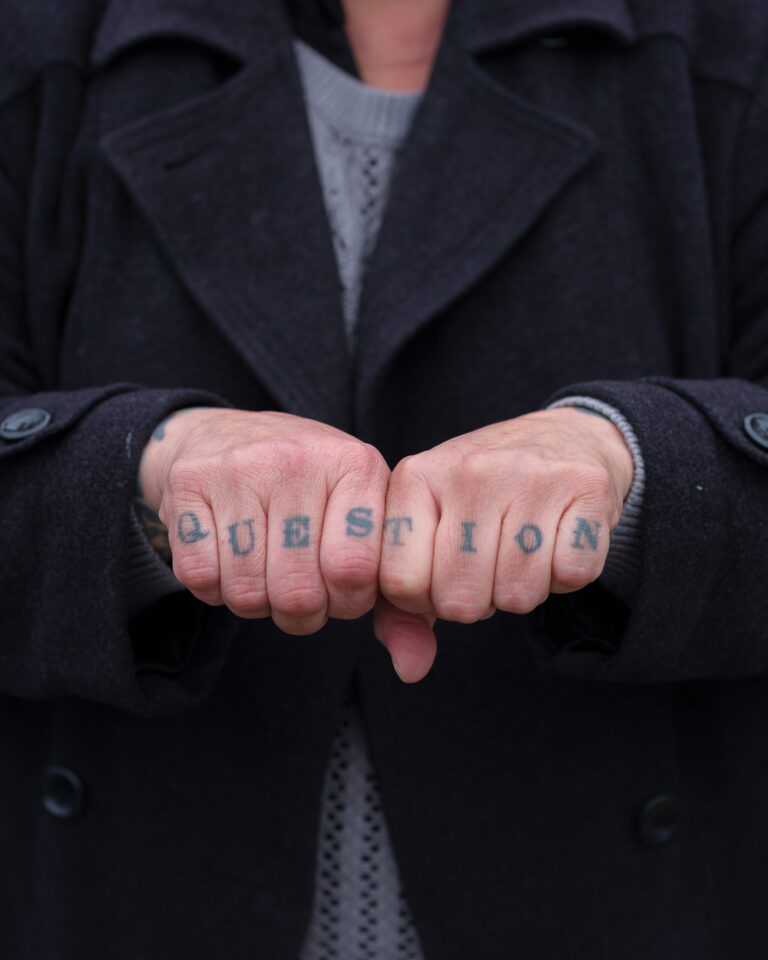
The mission to manifest new technologies like hydrogen and carbon capture has also elevated the profile of communities like Braddock as important exhibits in the national debate over environmental justice.
There, three women epitomize how the historic steelmaking community is becoming a centerpiece of environmental justice policy, imperiled but also empowered by efforts to build our energy future. In Braddock, a longtime community advocate works through struggles of the past, and in North Braddock, which calls itself the “birthplace of steel,” a borough council president sketches a vision for the future.
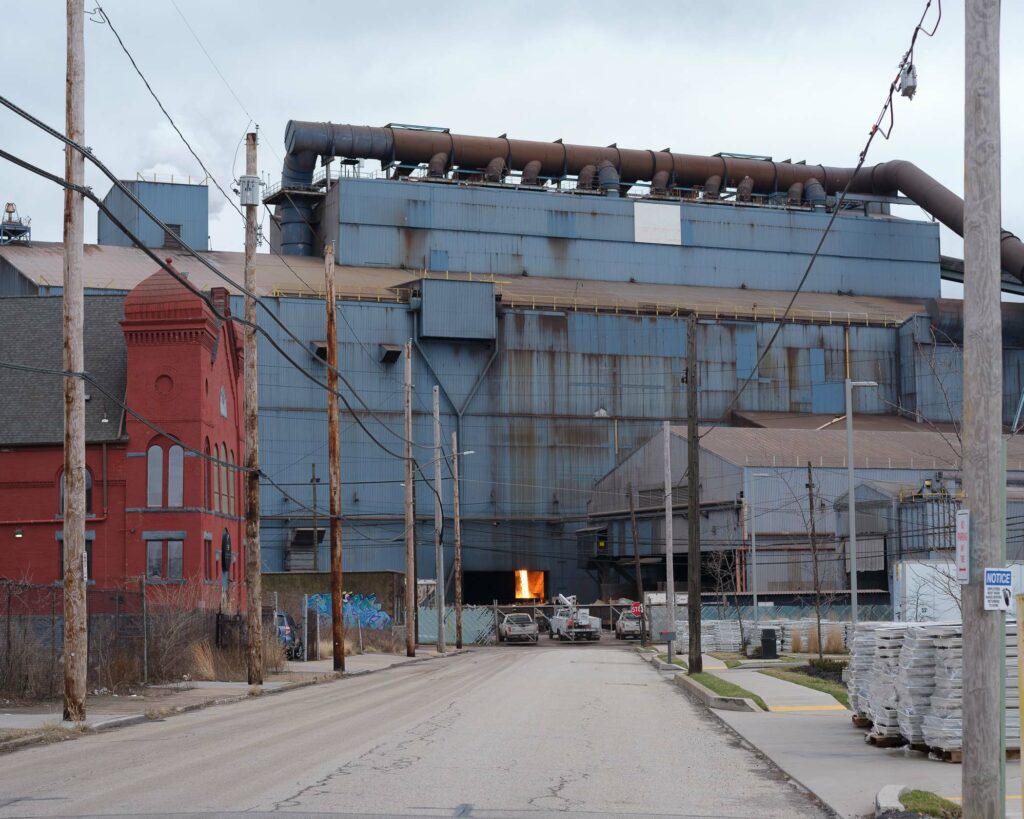
In August, accompanied by a van full of Mon Valley residents, Edith traveled to Washington, D.C., to meet with the director of the Office of Economic Impact and Diversity at the DOE. In September, she led a delegation of a dozen or so officials, including OCED Director David Crane, on a tour of communities in the Mon Valley.
“We were asked, what do we want?” Edith explained to the bureaucrats at the carbon workshop in December.
“We want what other communities and people have that don’t live in a sacrifice zone: health, prosperity, uninterrupted sleep, clean air, clean water, longevity, lead-free homes, transportation, healthy food, wellness and schools.” Her voice broke slightly.
“Why is it that these baselines for life are utopic expectations for people who live next to a source polluter?”
Washington: ‘Folks on the Ground Know’
The DOE’s Office of Clean Energy Demonstrations was born from the bipartisan infrastructure law in 2021, strapped with $25 billion and given an urgent mandate to help the U.S. achieve decarbonization goals in the face of a global climate crisis.
The office is demonstrating nascent technology for the first time, “but we also want to demonstrate how to do this while working hand-in-hand with communities,” said Suzy Baker, the DOE’s engagement lead on hydrogen.
For the past year or so, the DOE has been requesting information, hosting workshops and meeting with communities — “to understand where things have gone wrong in the past and what communities’ priorities and visions are for the future,” Baker said.
She acknowledged the limitations of a bureaucracy like the DOE to achieve restorative justice. Federal energy policy is forward looking, she said, and can fall short of taking responsibility for the ills of the past.
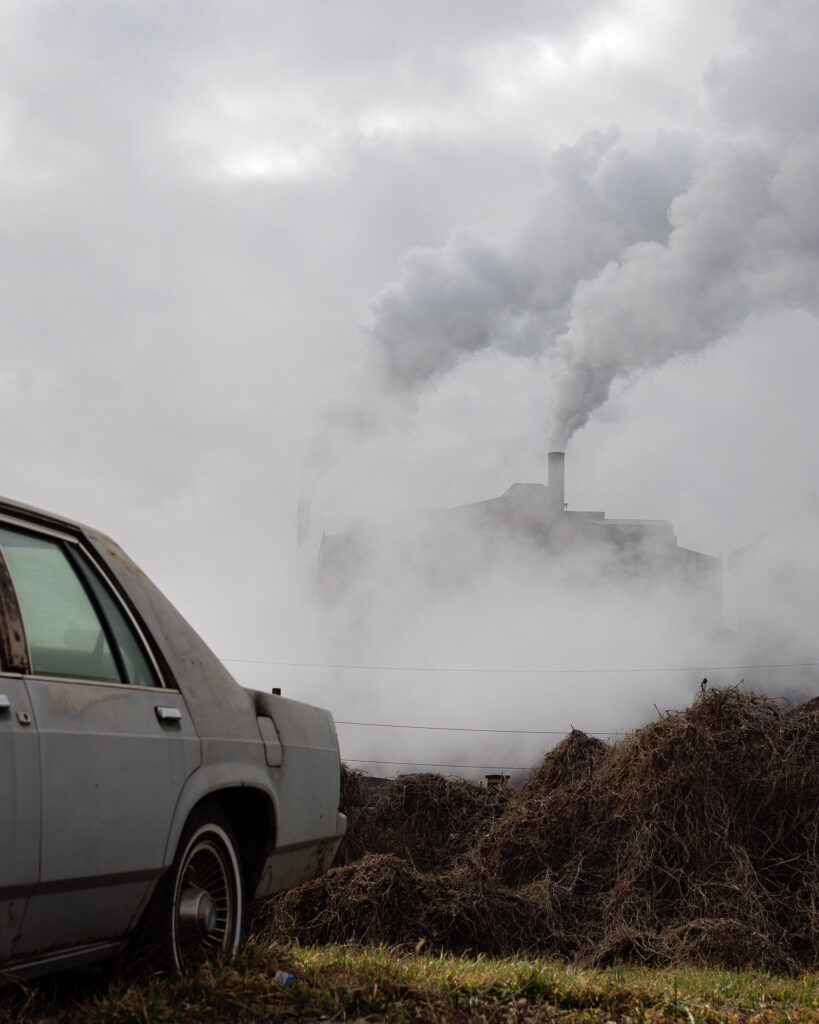
In recognition of the disruptive potential of new industry, the DOE mandates that funding proposals include community benefit plans that support “meaningful community and labor engagement,” workforce development, diversity, equity, inclusion and accessibility. The agency has also embraced the Biden Administration’s ‘Justice40’ initiative, which aims to allocate 40% of “overall benefits” for certain federal investments to “disadvantaged communities.” The DOE scores Braddock in the 99th percentile nationally on a scorecard of 36 “burden indicators.”
Eventually, through a process of merit reviews and scored rubrics, the office will decide which projects deserve federal funding. Community benefit plans are weighted to 1/5 of that calculus, on par with technical, economic and financial criteria.
“We want to empower communities to make their own determinations on their needs,” said Baker. “But truly, only folks on the ground know what is really needed.”
Mary: ‘We Need Little Things’
“It’s, like, really a ghost town. Only thing we missing is the tumbleweeds.”
A semi belched exhaust and roared past Mary Carey as she walked along the part of Braddock Avenue that’s flanked by train tracks on one side and a steel mill on the other.
Her feet stopped suddenly in the dirt.
“We don’t have no resources,” she said plainly. “Did you see any?”
There was the library, of course, where Mary worked for more than 10 years. It had a ceramics studio and a print shop and some programs to help people get jobs, but it’s closed now for renovations, and Mary was laid off in August.
A 20-year resident of Braddock, Mary is a helping hand in the community, among other things organizing a community oven in the summer.
She paused in front of Fifth Season, a robotic vertical farm housed in a warehouse across from the mill, heralded by many as a harbinger of positive change and jobs for the community. Her youngest son, now 19, had been hired to work there after he graduated from high school, but three days before he was due to start he was informed that the company had filed for bankruptcy. On this day, stacks of abandoned farming equipment stood outside the closed building.